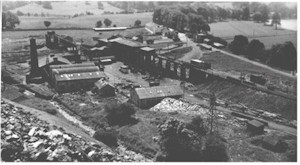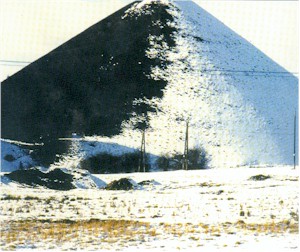The
Deerpark

An overview of the Deerpark Mines.
Horses, Ponies, Jinnets & Donkeys
The Deerpark was the the main mine in the Castlecomer Coalfield. It was the most spectacular and the best known mine in Ireland. Probably, but not definitely, it got it's name from, as the name suggests a Deer Park. Most likely the ground where the mine is situated was once home to a herd of deer possibly brought in to the country by the Wandesfordes family, owners of the Castlecomer Estate. The mine was sunk in 1924 and opened in 1928. It closed for the last time on the 25th. Jan. 1969

1000 lockers in the baths- 2 for each miner - 1 for clean clothes & 1 for pit clothes
The "Baths Building" originally opened on 18th. August 1939 and modernized in 1951
As you entered the deerpark gates the first building to greet you was the "Baths". This was a large building where the miners washed after their days work. It was built in 1939 and re-furbished to a high standard in 1951. This re-furbishment meant that the mines now boasted one of the most modern facilities in the country at that time. There were 1000 lockers in the building, 500 for clean clothes and 500 for pit clothes. Each miner therefore had two lockers and this meant that he could come to work in the morning in clean, dry clothes and return home in the evening in the same clothes. Before this the miners worked all day and returned home in the same clothes. The baths of course also contained beautifully finished showers. The walls of the shower cubicles were made from white glazed brick and were like the modern tiled showers. There was piping hot water available day and night from these showers. a number of men were employed to look after the baths, keep the boiler house going and look after the miners property in the locker room. At peak production time in the 1950's all the lockers were in use. The young miners would proudly display their "locker keys" to their friends who might still be in school. This was proof that they were "real miners"
Across from the baths close to the Clogh road was the bicycle shed. Everyone except the pit manager who had a car, either walked or cycled to work. It was not unusual to see three or four hundred bicycles in the "bike shed". The miners did not have to worry about their bikes being stolen as there was great comradeship between the men and to steal from one another was unheard of.
As you traveled up the yard on your left were a few offices and the "Ambulance Shed". The ambulance was a black van and you did not want to see it as when the ambulance was brought out it generally meant that somebody was badly injured or dead. All workers checked in at the offices each day. They were given their medal which was like an identity tag and using the number on the tag the office clerk recorded the various work done by the men and calculated their wage entitlements.
Just above the ambulance house was the "Grotto" where each miner knelt and prayed a little to Mary for a few moments each day before entering the bowels of the earth. The yard continued up the hill then to the pit head. Over the ditch on the left you had the home of the "Warde Family" -"Woodview House". This house was the original home of the "Brennan Clan" chiefs, rulers of the locality in ancient times.
The train passed across the yard between the baths and the offices to the lower end of the yard and to the left as you looked up towards the pit head from the baths. Here you had loading bays for the carriages. It was about 500 yards from this point to the pit head and all the way up along you had various buildings which did different jobs.
If you imagine yourself at the pit head looking down the yard you can get some idea of the buildings and their functions. The "Landing" was like a long bridge crossing a river. However, there were buildings or sheds on this "bridge" The landing started at the mouth of the mine. There was a steep fall of ground from here to the lower end of the yard. The landing was level and was built on large concrete pillars. As such carriages and carts could be pushed in underneath to be filled. When the coal trams came out of the mine they passed into sheds down along the landing known as the "Breaker" the "Washer" and the "Screener" where the coal was graded and prepared for market. Several men and boys worked on the landing, picking stones out of the coal, looking after the trams, grading, sorting and washing the coal. The coal then traveled on down to the end of the landing where it was loaded into carts drawn by horses or tipped in to the train carriages to be transported far and wide. Any stones, slates or imperfections were separated on the landing an sent up by tram to the top of "Bells Heap". On the near side of the landing you had stock piles of coal if supply exceeded demand.
On the far side of the landing you had the "Forge" and the "Saw Mill" the "Store" the "Power House" the small "Magazine" and some other small buildings.


Seamus Walsh tells us about the work in the mill
The Magazine with steel door where the Explosives were kept
The Forge and Sawmill were very busy places. All the miners tools were made and repaired in the forge. Picks, shovels, wedges, hammers etc. were kept in the best condition possible so that production would not be delayed. The props for the mines, doors, trams, handles for shovels and picks were just some of the items made by the skilled carpenters in the sawmill. Provisions were kept in the store while the powerhouse housed a generator which was run on steam and provided the mine with it's own electricity. Deerpark also purchased electricity from the E.S.B. The mine was actually the ESB's largest customer at that time. During the Winter, when there was a great demand for electricity the deerpark used it's own generator to supply power. This allowed the ESB to meet the demands of it's other customers.
The "Magazine" was a strong room that housed a small amount of explosives that would be required that day for blasting rocks out of the mine. A larger supply of explosives was kept in the big "Magazine" further up the yard and away from buildings and people in case the worst should happen.
Horses, Ponies, Jinnets & Donkeys
A lovely feature of the "Park Yard" was the constant jingle and rattle of horses, ponies, jinnets and donkeys as they pulled their carts up and down the yard. Some were drawing coal to customers in the locality while others could be setting out on a journey to Thurles or Tullamore with a ton of coal.
Bells heap was without doubt the most spectacular feature of the park. This monument, as it was also known covered over three acres of land and rose 350 ft. into the sky. We have described this landmark elsewhere on this website.


Former miner Seamus Walsh showing us the mouth of the tunnel where 600 men and boys headed off to work
The 350 ft. high "Bells Heap" which was created with "waste" from under the ground

Photograph of the Deerpark mine taken from the top of Bells Heap